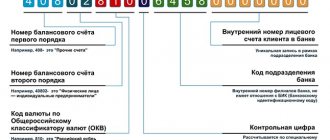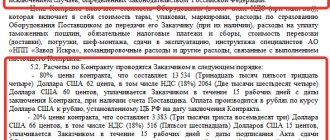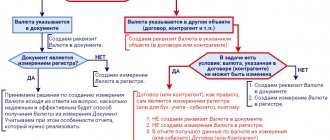Option one: payment received after shipment
In the buyer's accounting, costs arise in the form of the cost of the goods received, expressed in currency or conventional units. According to accounting standards, expenses must be recalculated at the exchange rate established on the date of shipment. This follows from paragraph 6 of PBU 3/2006 “Accounting for assets and liabilities, the value of which is expressed in foreign currency.” In tax accounting, costs are also recalculated at the exchange rate on the date of shipment (Clause 10, Article 272 of the Tax Code of the Russian Federation). Let us immediately make a reservation that hereinafter it is assumed that the purchasing company is on the general taxation system and uses the accrual method.
Next, the supply payables must be adjusted up or down, depending on whether the exchange rate increases or decreases. Adjustments are made through exchange rate differences.
The moment and procedure for determining exchange rate differences in tax and accounting are the same. This follows from paragraph 8 of Article 271 of the Tax Code of the Russian Federation, paragraph 10 of Article 272 of the Tax Code of the Russian Federation and from the provisions of PBU 3/2006. Thus, the exchange rate difference is formed on the last day of each month until full payment is made. Plus, the exchange rate difference is formed at the time of payment, both full and partial.
The exchange rate difference on the last day of each month is the cost of the unpaid part of the delivery in foreign currency or monetary units, multiplied by the difference between the two rates. The first rate is on the date of the previous recalculation (if there have been no recalculations yet, then on the delivery date). The second course is for the current date, that is, the last day of the month.
The exchange rate difference at the time of payment consists of two parts. To find the first part, you need to take the cost of part of the delivery (in foreign currency or cu), which is paid by the buyer. To find the second part, you need to take the cost of the remaining unpaid part of the delivery in foreign currency or cu. Both the first and second values must be multiplied by the difference between the two rates: on the date of the previous recalculation (if there have been no recalculations yet, then on the delivery date) and on the date of payment.
If the exchange rate has decreased since the previous recalculation (or delivery), then the resulting difference is positive. Both in tax and accounting it should be classified as non-operating income (subclause 11 of article 250 of the Tax Code of the Russian Federation and clause 13 of PBU 3/2006).
If the exchange rate has increased since the previous recalculation (or delivery), then the resulting difference is negative. Both in tax and accounting it is supposed to be written off as non-operating expenses (subclause 5, clause 1, article 265 of the Tax Code of the Russian Federation and clause 13 of PBU 3/2006).
Particular attention should be paid to VAT deduction. Its value is formed once - at the time of shipment at the rate established on the date of shipment. When making subsequent payments, the deduction amount is not adjusted, even if the exchange rate changes. Exchange differences (both positive and negative) are included in income and expenses along with VAT (clause 1 of Article 172 of the Tax Code of the Russian Federation).
Fill out and submit your balance using the current form Submit for free
Example 1 In March, Alpha LLC shipped to Betta LLC a consignment of goods with a total value of 120,000 conventional units (including VAT 20% - 20,000 USD). The exchange rate on the date of shipment was 45 rubles/cu. The exchange rate as of March 31 was 42 rubles/cu. In April, Betta LLC partially paid for the goods, transferring 40,000 USD to Alfa. at the rate of 40 rubles/cu. The exchange rate as of April 30 was 38 rubles/cu. In May, Betta finally paid for the goods, transferring the remaining 80,000 USD. at the rate of 35 rubles/cu.
Betta's accountant reflected these transactions as follows. In March, on the date of shipment, he made the following entries: DEBIT 41 CREDIT 60 - 4,500,000 rubles. ((120,000 c.u. – 20,000 c.u.) x 45 rub./c.u.) - reflects the cost of the goods received; DEBIT 19 CREDIT 60 – 900,000 rub. (20,000 c.u. x 45 rub./c.u.) - input VAT is reflected. Tax accounting includes costs associated with production and sales in the amount of RUB 4,500,000. On March 31, the accountant made the following entry: DEBIT 60 CREDIT 91 – 360,000 rubles. (120,000 c.u. x (45 rub./c.u. – 42 rub./c.u.) - a positive exchange rate difference is reflected when recalculating accounts payable at the rate on the last day of the month. In tax accounting, non-operating income was formed in in the amount of 360,000 rubles.
In April, on the date of transfer of money to the Alpha account, the accountant made the following entries: DEBIT 60 CREDIT 51 - 1,600,000 rubles. (40,000 c.u. x 40 rub./c.u.) - partial payment was transferred to the account of Alpha LLC; DEBIT 60 CREDIT 91 – 80,000 rub. (40,000 c.u. x (42 rub./c.u. – 40 rub./c.u.) - reflects the positive exchange rate difference when recalculating the amount of payment according to the kur on the day of payment; DEBIT 60 CREDIT 91 – 160,000 rub. . ((120,000 c.u. – 40,000 c.u.) x (42 rub./cu. – 40 rub./c.u.) - reflects the positive exchange rate difference when recalculating the balance of accounts payable at the exchange rate day of payment. In tax accounting, non-operating income was generated in the amount of 240,000 rubles (80,000 + 160,000). On April 30, the accountant made the following entry: DEBIT 60 CREDIT 91 - 160,000 rubles ((120,000 cu - 40,000 cu .u.) x (40 rub./cu - 38 rub./cu) - a positive exchange rate difference is reflected when recalculating the balance of accounts payable at the rate on the last day of the month. Non-operating income in the amount of 160 is generated in tax accounting 000 rub.
In May, the accountant made the following entries: DEBIT 60 CREDIT 51 – 2,800,000 rubles. (80,000 c.u. x 35 rub./c.u.) - the final payment was transferred to the account of Alpha LLC; DEBIT 60 CREDIT 91 – 240,000 rub. (80,000 c.u. x (38 rub./c.u. – 35 rub./c.u.) - a positive exchange rate difference is reflected when recalculating the payment amount at the rate on the day of payment. Tax accounting shows non-operating income in the amount 240,000 rub.
What is a currency clause and how to negotiate it in a contract
In practice, a currency clause is understood as a condition of an agreement, according to which the amount of payment under it will depend on the exchange rate of a certain currency. So, the following options are possible:
— the price in the contract is fixed in one currency (this is the currency of the obligation), and the payment will be made in another currency (this is the payment currency);
— the currency of the obligation and the currency of payment are the same (hereinafter referred to as the currency of the transaction), but the amount of payment depends on the change in the exchange rate of the currency of the transaction in relation to a more stable currency agreed upon by the parties (hereinafter referred to as the currency of the clause).
In contracts between Belarusian residents, the use of a currency clause is not always possible.
What is a currency clause?
The legislation does not contain the concept of “currency clause”. In practice, it is understood as a condition of the contract, according to which the amount of payment under it will depend on the exchange rate of a certain currency. So:
- either the currency of the obligation is fixed in one currency, and the currency of payment in another;
Note! The currency of the obligation expresses the monetary obligation, and the currency of payment is the currency in which this obligation is fulfilled, i.e. payment is made.
- either the obligation currency and the payment currency are the same (hereinafter referred to as the transaction currency), but the payment amount depends on the change in the exchange rate of the transaction currency in relation to a more stable currency agreed upon by the parties (hereinafter referred to as the reservation currency). For example, the parties chose the Belarusian ruble as the currency of the transaction, and the US dollar as the currency of the clause. If the exchange rate of the Belarusian ruble against the US dollar changes on the date agreed upon by the parties, compared to the exchange rate on the date of conclusion of the contract, both the price of the goods (work, services, etc.) and the amount of payment change proportionally.
Note: The purpose of a currency clause is to protect the parties from fluctuations in exchange rates.
How to reconcile a currency clause when the currency of the obligation and the currency of payment differ?
If the agreement is concluded between residents of Belarus
When the parties to the contract are residents of Belarus, then the goods (work, service, etc.) as a general rule must be paid for in Belarusian rubles <*>.
Note! The use of foreign currency when making payments between residents of Belarus is permitted only in cases provided for by law <*>. For example, payment in foreign currency is allowed under an agreement with a transport organization for the transportation of goods outside or from outside our country <*>.
The Belarusian ruble in the situation under consideration will be the payment currency. To agree on a currency clause, it is necessary to determine the currency of the obligation, i.e. indicate its name. The parties choose it at their own discretion <*>. However, since the payment must be in Belarusian rubles, the amount in foreign currency will need to be “translated” into Belarusian rubles. Therefore, we believe that you should choose a foreign currency as the liability currency, the exchange rate of the Belarusian ruble to which is set by the National Bank of Belarus.
Note! If the payment currency is a foreign currency, then the foreign currency, the official exchange rate of the Belarusian ruble to which is established by the National Bank of Belarus <*>, is necessarily used as the obligation currency.
Additionally, when drawing up a currency clause, it is advisable to agree on:
— the rate at which the amount payable under the contract will be determined. This condition is determined by the parties to the transaction <*>. This may be the rate of the National Bank of Belarus, the internal exchange rate of the bank of one of the parties to the agreement, etc.;
— the date or moment at which the corresponding exchange rate is taken. The parties to the transaction also determine this condition independently <*>. Typically this is the date of actual payment.
Examples of wording of conditions in the contract: “The price of the goods under this contract is 110 (one hundred and ten) US dollars per unit. Payment for goods is made in Belarusian rubles at the exchange rate of the Belarusian ruble to the US dollar established by the National Bank of the Republic of Belarus on the date of payment.”; “The cost of the goods under this agreement is an amount equivalent to 5,000 (five thousand) euros. Payment is made in Belarusian rubles at the euro purchase rate in effect on the date of payment at the bank serving the buyer."
Note! If the procedure for determining the exchange rate is not specified in the contract, then the amount payable in Belarusian rubles is determined at the official exchange rate of the corresponding currency on the day of payment <*>.
For agreements between residents in which the payment currency is foreign, the procedure for determining the rate for recalculating the amount payable under the agreement is not defined by law. Therefore, it must be agreed upon without fail.
An example of the wording of a condition in an agreement: “Payment is made in Russian rubles at the US dollar to Russian ruble exchange rate valid on the date of payment at the bank serving the customer.”
To avoid losses caused by sharp fluctuations in the exchange rate, the contract can provide for a currency corridor - the minimum and/or maximum rate at which payment will be made.
An example of the wording of a condition in an agreement: “The price of the goods under this agreement is 110 (one hundred and ten) US dollars per unit. Payment for goods is made in Belarusian rubles at the exchange rate of the Belarusian ruble to the US dollar established by the National Bank of the Republic of Belarus on the date of payment. However, the rate applied for payment purposes cannot be higher than 2.8 Belarusian rubles per US dollar and lower than 2.2 Belarusian rubles per US dollar. If the rate goes beyond the specified limits, the rate of 2.8 and 2.2 Belarusian rubles per US dollar will be applied, respectively.”
If the agreement is concluded between a resident of Belarus and a non-resident
When drawing up a currency clause in this case, you must indicate:
1) currency of obligation and currency of payment. In the contract, both the currency of the obligation and the currency of payment should indicate a foreign currency, the exchange rate of the Belarusian ruble to which is established by the National Bank <*>.
Note! Different countries have currencies with similar names. For example, US dollar and Canadian dollar, Norwegian krone and Czech koruna. Therefore, for an unambiguous interpretation of the terms on the currency, it is worth indicating its exact name in the contract;
2) the rate at which the cost of goods (work, services, etc.) under the contract will be recalculated. This condition is determined by the parties to the transaction. This may be the rate of the National Bank of Belarus, the rate of the national bank of the counterparty to the agreement, the internal exchange rate of the bank of one of the parties to the agreement, etc.;
3) the date or moment at which the corresponding rate is taken. The parties to the transaction also determine this condition independently. Typically this is the date of actual payment. For example, if you select the currency purchase rate at the bank of one of the parties to the transaction, then it can be determined on the date of payment at the corresponding bank.
An example of the wording of a condition in an agreement: “The cost of services under this agreement is determined in euros. All payments under this agreement are made in Russian rubles at the euro purchase rate in effect on the date of payment at the bank serving the customer.”
To avoid losses caused by sharp fluctuations in the exchange rate, the contract can also provide for a currency corridor - the minimum and/or maximum rate at which payment will be made.
An example of the wording of a condition in an agreement: “Payment is made in Russian rubles at the US dollar to Russian ruble exchange rate established by the Bank of Russia on the date of submission of the payment order to the bank. However, the rate applied for payment purposes cannot be higher than 75 Russian rubles per US dollar and lower than 45 Russian rubles per US dollar. If the rate goes beyond the specified limits, the rate of 75 and 45 Russian rubles per US dollar will be applied, respectively.”
How to agree on a currency clause when the currency of the obligation and the currency of payment coincide?
To agree on this clause, you must indicate:
1) transaction currency;
2) the currency of the reservation, i.e. currency, the change in exchange rate of which will determine the amount of payment;
3) what course will be compared. As a rule, the official rate is chosen, but the parties have the right to agree on a different rate. For example, the internal exchange rate of the bank of one of the parties to the agreement;
4) on what dates the rate is compared. This is usually the date the contract was concluded and the date of payment. The parties can choose any dates;
5) how the payment amount changes depending on changes in the exchange rate. In practice, the parties agree that the payment amount is recalculated in proportion to the change in the exchange rate.
We also recommend setting a maximum value for the exchange rate difference, upon reaching which a recalculation will be made. This will allow you to avoid recalculating the payment amount if the exchange rate fluctuates slightly.
An example of the wording of a condition in a contract: “The price of the goods is 200,000 (two hundred thousand) Russian rubles, payment for the goods is made in Russian rubles. If the exchange rate of the US dollar to the Russian ruble, established by the Bank of Russia, on the date of payment changes compared to the rate on the date of conclusion of the agreement by more than 5%, then the payment amount is recalculated in proportion to the change in rate.”
When can a currency clause not be used in contracts between residents?
For some types of contracts, the procedure for determining the price is fixed in law and cannot be changed by agreement of the parties. We believe that in such cases the use of a currency clause is impossible. For example:
- in lease agreements for capital buildings, premises, parking spaces that are state-owned, as well as owned by economic entities, in the authorized capital of which more than 50% of the shares (shares) belong to the state <*>;
- in lease agreements for machinery, equipment, vehicles, and other movable property related to fixed assets that are in state ownership <*>;
- in lease agreements for land plots owned by the state <*>;
— in construction contracts, when a fixed contractual price is formed <*>.
Read this material in ilex >> *follow the link you will be taken to the paid content of the ilex service
Option two: payment was received before shipment took place
If the buyer makes a 100% prepayment, then he generates expenses in the form of the cost of the goods at the time of transfer of money at the rate on the date of prepayment. Subsequently, during shipment, no adjustments are made, and exchange rate differences are not generated. In the accounting rules, this norm is enshrined in paragraph 9 of PBU 3/2006. In tax accounting, the absence of exchange rate differences when making an advance payment is stated in subparagraph 11 of Article 250 of the Tax Code of the Russian Federation and in subparagraph 5 of paragraph 1 of Article 265 of the Tax Code of the Russian Federation.
The VAT deduction is also generated once - at the time of transfer of the advance payment. The amount indicated by the supplier in the “advance” invoice and calculated at the exchange rate on the date of the advance is accepted for deduction. Further, at the time of shipment, the supplier does not recalculate the VAT amount, as the Federal Tax Service reminded in letter No. ED-4-3/12813 dated July 21, 2015 (see “The Federal Tax Service clarified the procedure for issuing invoices under foreign exchange agreements”). Therefore, the buyer should not recalculate the deduction amount.
Example 2 According to the agreement, Wholesaler LLC must supply products worth 240,000 USD to Magazin LLC. (including VAT 20% - 40,000 USD). In turn, the “Store” undertakes to make a 100% prepayment. In July, “Store” transferred 240,000 USD to the account of “Wholesaler”. at the rate of 55 rubles/cu. In August, “Wholesaler” shipped all the goods to “Store”. The exchange rate on the date of shipment was 60 rubles/cu. The accountant of the “Store” reflected these transactions as follows:
In July, he made the following entries: DEBIT 60 CREDIT 51 - 13,200,000 rubles. (240,000 c.u. x 55 rub./c.u.) - one hundred percent prepayment was transferred to the account of Wholesaler LLC; DEBIT 68 CREDIT 76 – 2,200,000 rub. (40,000 c.u. x 55 rub./c.u.) - accepted for deduction of VAT on prepayment.
In August, the accountant made the following entries: DEBIT 41 CREDIT 60 - 11,000,000 rubles. ((240,000 c.u. – 40,000 c.u.) x 55 rub./c.u.) - reflects the cost of the goods received; DEBIT 19 CREDIT 60 – 2,200,000 rub. (40,000 c.u. x 55 rub./c.u.) - input VAT reflected; DEBIT 68 CREDIT 19 – 2,200,000 rub. — input VAT is presented for deduction; DEBIT 76 CREDIT 68 – 2,200,000 rub. — VAT, previously accepted for deduction from the advance payment, has been restored. Tax accounting includes costs associated with production and sales in the amount of 11,000,000 rubles. The accountant did not make any recalculations or adjustments due to exchange rate changes.
Get a free sample accounting policy and do accounting in a web service for small LLCs and individual entrepreneurs
Regulatory regulation
Revenue expressed in yuan. That is, in the Accounting and National Institutions it is subject to conversion into rubles (paragraph 2, 3, paragraph 9 of PBU 3/2006, Article 316 of the Tax Code of the Russian Federation):
- with 100% prepayment - at the exchange rate on the date of prepayment;
- with 100% postpayment - at the exchange rate on the date of transfer of ownership;
- in case of partial prepayment and postpayment under the contract: the paid part - at the exchange rate on the date of prepayment;
- unpaid portion - at the exchange rate on the date the goods were accepted for accounting.
The tax base for VAT is determined as of the earliest date (clause 1 of Article 167 of the Tax Code of the Russian Federation):
- day of shipment;
- payment day.
When selling with prepayment, the VAT base is determined twice (Letters of the Ministry of Finance of the Russian Federation dated December 23, 2015 N 03-07-11/75467, dated February 17, 2012 N 03-07-11/50):
- upon receipt of partial payment;
- directly upon shipment of goods.
Upon subsequent payment, VAT is not recalculated and adjusted.
Payment period
44-FZ prohibits payment periods that are too long. This was done to ensure competition and prevent restrictions on the number of procurement participants. When determining the payment procedure, the customer is obliged to comply with the requirements of Part 8 of Art. 30 and part 13.1 art. 34, according to which this period should not be more than 30 days from the date of signing the acceptance documents. And if only small businesses (SMBs) or socially oriented non-profit organizations (SONOs) can participate in the procurement, no more than 15 working days. The customer has the right not to include such a condition in cases provided for in Part 15 of Art. 34.
A change in payment terms under contract 44-FZ is a change in its essential terms. This is permissible only in certain cases; we talked about them in the article “Essential terms of the contract under 44-FZ”.
IMPORTANT!
You can only reduce the period established by law.
It is recommended to set the payment in the contract in calendar days, and not in a period of time (for example: “Calculation is made within 10 days after signing the acceptance certificate.” It is necessary: “The customer makes payment no later than 01/01/2017”).
Even after calculating in advance the duration of the contract under 44-FZ, for one reason or another, it is possible to change the terms of the contract under 44-FZ, which, in turn, leads to a new period for fulfilling obligations under the contract.





